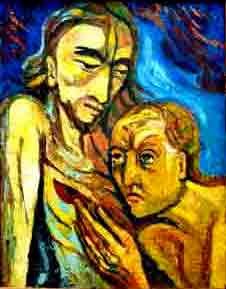My Lord and my God!
“I had heard of you by the hearing of the ear, but now my eye sees you.”
Indian artist Jyoti Sahi depicts Thomas and the Wound. Thomas the Twin, the Doubter, has become in Sahi’s imagination one who reclines on Jesus’s chest like the Beloved Disciple, gently probing the wound in the side of the risen Christ. Christ, meanwhile, is ghastly and emaciated, tinged with unreal hues of blue and green. Is this perhaps the lack of “form and beauty” to make him desirable, spoken of by the Prophet? Or is it this the unsettling transformation that has occurred in the risen body of our Lord? Or does Thomas’s lingering uncertainty project onto Jesus as an ugly uncertainty?
Put your finger here, and see my hands; and put out your hand, and place it in my side. Do not disbelieve, but believe.
— Our Risen Lord Jesus Christ, the Son of God (John 20:27)
Here’s another intriguing treatment of the subject of Thomas’s doubt — although it is less immediately attractive...and it’s connection to the Biblical narrative is more subtle. This is Robert Rauschenberg (1925–2008), Untitled, ca. 1955. The analysis of art critic Jonathan Anderson and theologian William Dyrness puts the piece into context:
Rauschenberg’s Untitled black painting with a funnel (c. 1955) is presented as a kind of figure: the open circular collar of a t-shirt positions a head relatively high in the field, and the fragment of a sleeve on the right-hand edge indicates a lifted hand. Nearly all of the collaged scraps of cloth and paper on the surface are painted over in flat black paint—one of the few portions that is not is a prayer card just to the right of the center of the painting that displays a reproduction of Carl Bloch’s Doubting Thomas (1881). Flurries of red, yellow, green and white paint have been slashed across the surface immediately below this image (the only place such color appears in the painting), which within the figure suggested by the cloth fragments correspond to the position of the wound in Christ’s side, as depicted in the prayer card. The painting’s surface subtly stands in for the wounded body of the resurrected Jesus, and as such the ball of twine placed in the funnel on the left side of the panel becomes doubly suggestive of incarnation (descending downward into the funnel) and ascension (being pulled upward out of the funnel). But if Rauschenberg is allegorizing the surface of the painting with the resurrected body of Christ, then he is also placing himself (and the viewer) in the position of the incredulous Thomas. It is a painting that powerfully articulates both a longing to touch and see (Lk 24:39; cf. Lk 6:19) and the persistence and seeming ineluctability of doubt in the age of modernity (including doubt that images, much less paintings, can any longer serve as vehicles for the kind of religious touching and seeing that we long for). Like much modern art, this is not a work of unbelief as much as it is of fragilized belief, one that is caught oscillating (or struggling) between doubt and belief.
Modern Art and the Life of a Culture: The Religious Impulses of Modernism (Downers Grove, IL: InterVarsity Academic, 2016), 308-309.
Second Sunday of Easter
Texts for Today
Prayer
Almighty and everlasting God, who in the Paschal mystery established the new covenant of reconciliation: Grant that all who have been reborn into the fellowship of Christ’s Body may show forth in their lives what they profess by their faith; through Jesus Christ our Lord, who lives and reigns with you and the Holy Spirit, one God, for ever and ever.
Glory, Hallelujah!
The ChurchFolk Project out of College Church in Wheaton plays the haunting folk anthem from the American Sacred Harp tradition: SHOUT ON, with the words of the English Baptist poet, Samuel Medley’s 1775 words, “I know that my Redeemer lives, what comfort this sweet sentence gives.” Interestingly, the tune SHOUT ON is performed only with these lyrics, which have merged with one of the old revivalist “shout songs,” “Shout Old Satan's Kingdom Down." In the Sacred Harp, it’s called “Antioch 277” (You can see it hauntingly performed in the old style by the Second Ireland Sacred Harp convention here). But Medley’s words are also sung to a number of other tunes, reflecting the enduring popularity of the song outside of the frontier revivalist community, even as it became a staple of American folk spirituality.





